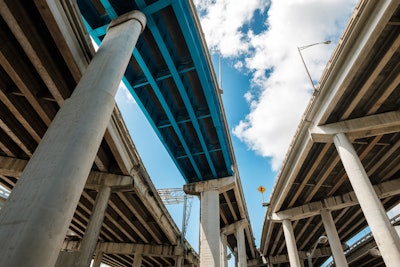
Lately, I’ve been hearing a lot of questions asking when we might start to see federal infrastructure funding really impacting the market. I thought it would be a good time to talk a little about the Infrastructure Investment and Jobs Act (IIJA), its available funds for projects and how contractors can position themselves to take advantage of these new jobs by leveraging technology.
Let’s start at the beginning of this historic congressional bill, look at its timeline and consider how the new law affected the construction industry market.
Fall 2021: IIJA Signed Into Law
The IIJA was signed into law on Nov. 15, 2021, with approximately $550 billion (about $1,700 per person in the U.S.) in new spending, making this the highest government funding dedicated to infrastructure in over a decade. Combined with existing funding, the IIJA will distribute $1.2 trillion during the next 10 years on projects such as roads, bridges, public transit, broadband and clean energy.
The funds from the IIJA are administered by various federal agencies, depending on the program or project. Since roads and bridges are the biggest program area of funding, the Department of Transportation (DOT) has the greatest oversight over IIJA funding, but additional agencies are responsible for different infrastructure projects including:
- Broadband infrastructure projects are facilitated by the Federal Communications Commission.
- Water infrastructure, including the upgrading of drinking water and wastewater systems, is managed by the Environmental Protection Agency.
- Energy-related projects, including EV charging stations and upgrades to the nation’s electric grid, are directed by the Department of Energy.
- Development of regional innovation strategies designed to promote economic growth through innovation and entrepreneurship are being overseen by the Department of Commerce.
Summer 2022: Grants Announced
Government agencies started to roll out grant applications and their deadlines as specific projects were approved. These agencies explained how the distribution of funds works — a combination of formula grants for states where amounts were determined based on population or state size; and competitive grants, which cities, towns and municipalities can apply to receive.
Formula grants: Some $300 billion in formula grants are dedicated to roads and bridges. Many of these funds will go to the two states with the most highway infrastructure, California ($44.5 billion), and Texas ($35.4 billion).
Competitive grants: Awarded using a competitive process, some deadlines for these grants have already passed. (The White House highlighted projects funded by Competitive Grants in late 2022.) And by February 2023, the White House did announce more projects funded by competitive grants. While states receive a formula grant based on a combination of factors, they can also apply for grants to receive funding for specific programs.
Fall 2022: Infrastructure Coordinators Appointed
To administer the IIJA funds, state officials appointed an infrastructure coordinator to monitor allocations and ensure projects were on track and on budget. In November, the DOT highlighted several projects ranging from $1.6 to $25 million in several states.
For example, OPS Contractors continue to work on the 2nd Street Revitalization project in Tucson, Ariz., to replace an existing 1960s-era bridge in poor condition with a new bridge over the Union Pacific Railroad and State Route 210. A $25 million RAISE (Raise America Infrastructure with Sustainability and Equity) grant funds this project and expands high-traffic areas from four lanes to six lanes, creating additional bicycle and pedestrian bridges.
In speaking with contractors across the country, the bulk of IJA-funded jobs have a longer design (pre-construction) phase than other projects. Complicating matters even more are factors such as decreased purchasing power, administrative challenges, and the made-in-the-U.S.A. requirements associated with the funding. Nonetheless, most contractors are bullish about the upcoming construction season and what lies ahead.
Spring 2023 And Beyond: Contractors Get Ready
We anticipate an uptick in projects getting underway this season. As contractors prepare to bid, consider new construction technology to meet precision requirements and maximize productivity. Here are three recent developments in construction technology to help you meet the demands of these new projects
1. Intelligent paving equipment and construction technology
The paving and asphalt market has experienced significant growth over the last few years and, with the new funding for roads and bridges, there are no signs of slowing down. However, contractors are looking at tighter agency specifications, smaller bid margins, and a challenging labor market. Manufacturers like the WIRTGEN GROUP have responded to this need by developing more fuel-efficient cold milling machines like the W120Ri and integrating machine control features to assist less experienced operators.
GPS technology has also advanced where cloud-based machine monitoring software can now measure accuracy within a millimeter in real-time. Companies like Topcon leverage the Global Navigation Satellite System (GNSS) for horizontal accuracy with a rotating laser for vertical accuracy.
Contractors building roads can integrate machine control systems with site management software to increase roadbuilding consistency and productivity.
2. Precise and semi-autonomous equipment technology
While the industry focuses on getting enough skilled labor to meet the expected building demands, many manufacturers have developed equipment that can be semi-autonomous. Today, equipment like large wheel loaders and pile drivers can be controlled remotely. Semi-autonomous pile drivers help maximize operator consistency on solar panel installations where piles and depths must be in precise locations for the solar panel to operate at its highest capacity. Semi-autonomous wheel loaders allow one operator to run multiple machines in load and carry applications. Both examples show how semi-autonomous equipment technology can improve safety on jobsites and allow more candidates to be equipped to handle the job as machines are operated from an office and not in the field.
3. Integrated fleet management technology to monitor equipment and jobsites
Many companies like Topcon, John Deere and WIRTGEN Group have been working on developing software solutions to integrate the software with cameras and sensors on equipment to automatically generate summary reports on materials, people, and equipment. From these reports, contractors can use the fleet management software to prepare insights about a project’s development, improve its status visibility and monitor key performance indicators like the current number of cubic yards paved. When software is integrated into the machine control and monitoring features, contractors access vital job status info in real-time when they need to send regular reports to local and state officials.
In 2023, contractors are more open than ever to onboard technology solutions in an ever-changing market, as one factor remains the same — the need to be consistently productive.
To view additional information and quickly sort programs funded under the IIJA by fields like amount, eligible recipient, or program name, visit Build.gov. See roads and bridges projects, reference the DOT’s reference this Notice of Funding Opportunities. Applicants for funding should consult program-specific guidance. For additional information and to apply, visit Grants.gov.




















